Bangkok’s three must-see temples—Wat Traimit, Wat Pho, and Wat Arun—stand as testaments to the city’s deep-rooted spiritual and cultural history. Wat Traimit captivates visitors with its solid gold Buddha, while Wat Pho, home to the Reclining Buddha, serves as a hub for traditional Thai massage. As for Wat Arun, its stunning riverside architecture invites contemplation of the cosmos. Each temple not only showcases artistic mastery but also offers insights into local customs and practices. Understanding their significance could profoundly enhance one’s experience in this vibrant city. What stories do these sacred spaces hold?
Good To Know

- Wat Traimit features a 5.5-tonne solid gold Buddha statue, showcasing its historical and cultural significance in Chinatown.
- Wat Pho is home to the iconic 46-meter Reclining Buddha and is known for its beautiful murals and traditional Thai massage school.
- Wat Arun’s stunning central prang symbolizes Mount Meru and is adorned with colorful porcelain, reflecting Thailand’s artistic heritage.
- Each temple offers a unique spiritual experience and insights into Thailand’s rich cultural traditions and history.
- Visiting these temples provides a deeper understanding of Bangkok’s vibrant community and the vital role of Buddhism in daily life.
Overview of Bangkok’s Temples
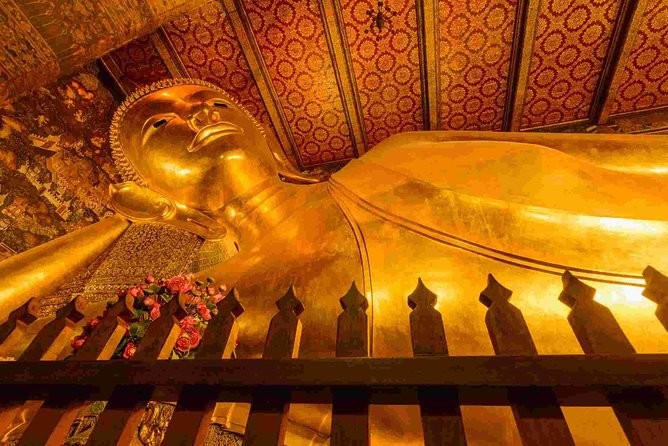
Bangkok’s temples stand as stunning testaments to the city’s rich cultural heritage and architectural brilliance.
Each temple, or wat, offers unique insights into Thailand’s spiritual and artistic traditions. Visitors can marvel at intricate designs, vibrant murals, and serene statues that reflect centuries of devotion and craftsmanship.
The temples aren’t just places of worship; they’re cultural hubs that host festivals and rituals, drawing locals and travelers alike. Exploring these sacred sites provides a deeper understanding of Thailand’s history and its people’s values.
Whether it’s the golden spires of Wat Arun or the serene atmosphere of Wat Pho, Bangkok’s temples promise an enriching experience for anyone eager to connect with the city’s spiritual heart.
You can also read our reviews of more tours and experiences in Bangkok.
Wat Traimit Highlights
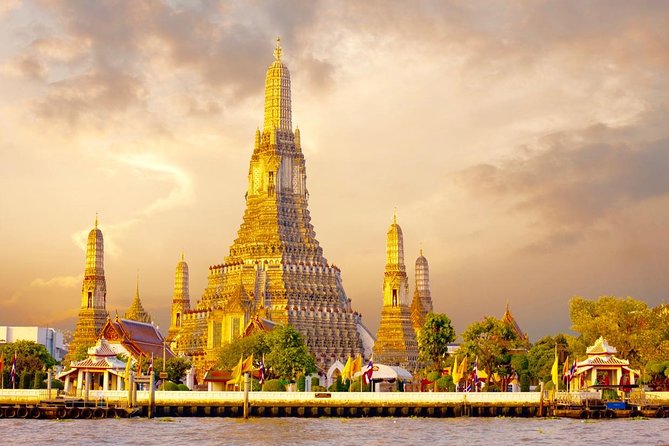
One of the standout temples in Bangkok is Wat Traimit, renowned for its impressive seated Buddha statue that weighs an astonishing 5.5 tonnes. This remarkable statue, crafted from solid gold, stands nearly 5 meters tall and dates back to the 13th century.
Located in the bustling Chinatown area, Wat Traimit attracts visitors with its stunning architecture and rich history. The temple features intricate decorations and offers a serene atmosphere amidst the city’s hustle and bustle.
Visitors can explore the museum on-site, which showcases the statue’s fascinating backstory and the temple’s significance. With its captivating beauty and cultural importance, Wat Traimit is a must-visit destination for anyone exploring Bangkok’s vibrant temple scene.
Wat Pho Features
Wat Pho, often regarded as one of Bangkok’s most iconic temples, boasts the remarkable Reclining Buddha, which stretches an impressive 46 meters in length. This magnificent statue is adorned with gold leaf and intricately detailed mother-of-pearl inlays on its feet, showcasing traditional Thai craftsmanship.
Visitors can explore the temple grounds, home to over a thousand Buddha images and stunning murals that depict Buddhist teachings. Wat Pho is also Thailand’s first school of traditional medicine, offering authentic Thai massage and wellness treatments.
The temple’s serene atmosphere invites reflection, making it an ideal spot for both travelers and locals seeking tranquility amidst the city’s hustle. A visit to Wat Pho is a must for anyone wanting to experience Thailand’s rich cultural heritage.
Wat Arun Architecture
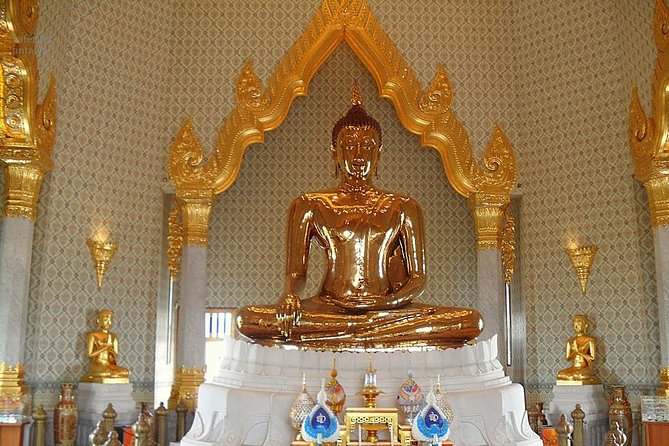
Rising majestically along the Chao Phraya River, Wat Arun captivates visitors with its stunning architectural design and intricate details. The temple’s iconic central spire, or prang, reaches 82 meters high, adorned with colorful porcelain and seashells that shimmer in the sunlight. Its design reflects the Khmer influence, showcasing a unique blend of Thai artistry and cultural heritage. The temple’s surrounding structures, including smaller stupas and intricate murals, further enhance its breathtaking appearance.
| Feature | Description | Significance |
|---|---|---|
| Central Prang | 82 meters tall | Symbolizes Mount Meru, the center of the universe |
| Porcelain | Colorful ceramics and seashells | Represents wealth and artistry |
| Surroundings | Smaller stupas and murals | Depict stories of Buddhist lore |
| Architecture | Khmer-inspired style | Reflects Thailand’s cultural blend |
| Location | Riverside position | Offers stunning views of the river |
Cultural Significance of Temples

Bangkok’s temples serve as vital pillars of the city’s cultural and spiritual landscape, embodying centuries of tradition and history.
These sacred spaces not only attract travelers but also foster deep-rooted connections among locals. Temples play a crucial role in daily life and community events, reinforcing the importance of Buddhism in Thai culture.
-
They serve as centers for meditation and education.
-
Temples host traditional festivals that strengthen community ties.
-
Architectural styles reflect historical influences and local artistry.
-
They offer a sanctuary for spiritual reflection and renewal.
-
Temples are often linked to local legends, enriching cultural storytelling.
In essence, these temples are more than just beautiful structures; they’re living embodiments of Bangkok’s cultural identity.
- Pattaya: Dropzone Tandem Skydive Experience With Ocean Views
- Bangkok DMK Airport: Private Transfer To/From Hua Hin City
- Bangkok: Wat Pho and Wat Arun Guided Walking Tour
- Bangkok: Midnight Food Tour by Tuk-Tuk
- Bangkok’s Iconic Chinatown Experience: Sites & Street Bites
- Bangkok Day Tour: Food, Temple & Tuk-Tuk
Tour Logistics and Inclusions
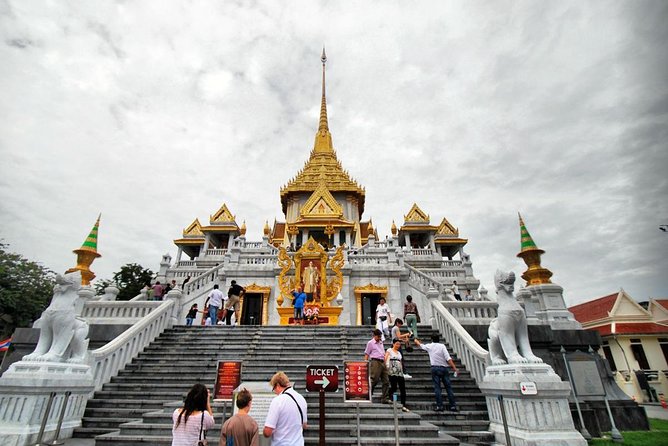
Exploring the temples of Bangkok comes with well-organized tour logistics designed for a seamless experience. Participants can expect a professional English-speaking guide to lead the way, ensuring an informative visit.
For those opting for private tours, hotel pickup and drop-off are included, adding convenience. Travelers enjoy air-conditioned vehicles and entrance tickets to Wat Traimit and Wat Pho, enhancing comfort and accessibility.
Meeting points are easy to locate, with options like Hilton Garden Inn Bangkok Silom and Novotel Hotel Ploenchit. While the tour isn’t wheelchair accessible, strollers can easily navigate.
With a cancellation policy allowing free changes up to 24 hours prior, visitors can book with confidence, knowing flexibility is available.
Visitor Tips and Recommendations

For a memorable visit to Bangkok’s temples, travelers should consider a few key tips to enhance their experience.
Preparing ahead can make all the difference in enjoying the cultural richness these sites offer.
-
Dress respectfully; cover shoulders and knees.
-
Visit early in the day to avoid crowds and heat.
-
Bring water and stay hydrated as you explore.
-
Hire a local guide for insightful stories and context.
-
Respect the customs and quiet atmosphere of the temples.
Additional Attractions Nearby
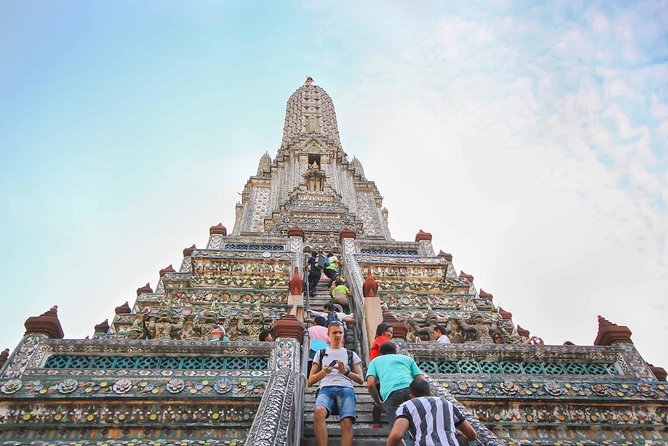
While visiting the renowned temples of Bangkok, travelers can easily extend their cultural experience by exploring nearby attractions that showcase the city’s rich heritage.
Just a short walk from Wat Pho lies the Grand Palace, an architectural marvel that served as the royal residence for over 150 years. Visitors should also check out the Emerald Buddha Temple, housing the revered statue that symbolizes Thailand’s spiritual heart.
For those interested in local culture, the bustling markets around Chinatown offer a vibrant shopping experience, filled with street food and unique souvenirs.
Plus, a relaxing boat ride along the city’s canals provides a different perspective of Bangkok, often referred to as the "Venice of the East."
These attractions enhance any visit to Bangkok’s temples.
Frequently Asked Questions
What Is the Best Time to Visit These Temples?
The best time to visit these temples is early morning or late afternoon. During these hours, visitors enjoy cooler temperatures, fewer crowds, and stunning lighting for photography, enhancing their overall experience of Bangkok’s rich cultural heritage.
Are There Dress Code Requirements for Temple Visits?
When visiting temples, visitors must adhere to dress code requirements. They should wear modest clothing, covering shoulders and knees. Flip-flops aren’t allowed; closed-toe shoes are recommended to show respect for these sacred places.
How Long Should I Spend at Each Temple?
When visiting each temple, she recommends spending about 30 to 45 minutes. This allows ample time to appreciate the architecture, take photos, and soak in the serene atmosphere without feeling rushed during the experience.
Is Photography Allowed Inside the Temples?
Visitors should note that photography rules vary by temple. While some allow photos, others prohibit them to preserve sacredness. It’s best to check specific guidelines upon arrival to ensure respectful practices during their visit.
Are There Food Options Near the Temples?
Nearby the temples, visitors can find various food options, including street vendors and local restaurants. They offer delicious Thai cuisine, making it easy for travelers to enjoy authentic meals before or after exploring the sights.
The Sum Up
To sum it up, Bangkok’s trio of must-see temples—Wat Traimit, Wat Pho, and Wat Arun—offers visitors a rich tapestry of spiritual and cultural experiences. Each temple showcases unique architectural beauty and deep-rooted traditions, making them essential stops for anyone exploring the city’s heritage. With thoughtful planning and a spirit of curiosity, travelers can fully appreciate the significance of these iconic sites. A visit to these temples not only illuminates Bangkok’s past but also enriches one’s understanding of Thai culture today.
More Tour Reviews in Bangkok
- Bangkok: Boat Bliss Riverside Cruise Tour and Wat Arun Visit
- Bangkok: Tuk-Tuk Ride, Wat Arun, and Flower Market Tour
- Bangkok 3-Major Royal Temples Walking Tour
- Bangkok: Damnoen Saduak Floating & Train Market Private Tour
- Full-Day Temple Tour in Bangkok With a Professional Driver.
- Bangkok: Full Day Tour With Experienced Guide – Private
Not for you? Here's more nearby things to do in Bangkok we have reviewed
- Bangkok: Boat Bliss Riverside Cruise Tour and Wat Arun Visit
- Bangkok: Tuk-Tuk Ride, Wat Arun, and Flower Market Tour
- Bangkok 3-Major Royal Temples Walking Tour
- Bangkok: Damnoen Saduak Floating & Train Market Private Tour
- Full-Day Temple Tour in Bangkok With a Professional Driver.
- Bangkok: Full Day Tour With Experienced Guide – Private
- Bangkok: Grand Palace, Wat Pho & Long Tail Boat Tour
- Bangkok: Banyan Tree Hotel Staycation Packages
- From Bangkok or Hua Hin: Hua Hin Tour With Private Charter
- Ayutthaya: Historical City Tour With Optional Boat Ride
- Bangkok: 2-Day River Kwai Trip With Floating Hotel and Meals
- Bangkok: Instagram Tour With Professional Photographer
